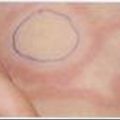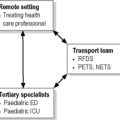7.1 Abdominal pain
Introduction
Abdominal pain is a common reason for children to attend an emergency department (ED), occurring in up to 5% of all presentations in some institutions.1 Most commonly the underlying cause is non-surgical and surgery is required in only 1–7% of children who present with abdominal pain.1,2 It is not possible to make a definitive diagnosis in all children with abdominal pain. In one study, as many as 15% of children presenting to emergency with abdominal pain did not have a specific diagnosis at their discharge. Some children arrive at the ED soon after the onset of symptoms and it may take time, expectant management and review before a diagnosis becomes clearer or the symptoms of a self-limiting cause resolve. It is important, however, to exclude causes of abdominal pain that may require early surgical consultation, observation or investigations within the ED.
The priorities in managing children presenting with abdominal pain are:
Pathophysiology
The sensation of abdominal pain is transmitted by either somatic or visceral afferent fibres.3 Visceral pain from visceral peritoneum is poorly localised, whereas somatic pain arising from parietal peritoneum or the abdominal wall is more localised. Referred pain also occurs due to visceral and somatic pathways converging in the spinal column. Two examples of referred pain are diaphragmatic irritation leading to pain at the shoulder tip due to convergence of visceral and somatic pathways at C4, and somatic pain from pneumonia leading to T10–11 pain sensed in the lower abdomen.3 Abdominal pain may occasionally be found to be psychosomatic in origin after a thorough assessment of alternative causes.
Aetiology
There is a broad range of causes of abdominal pain in children and one needs to initially keep an open mind regarding the diagnosis (Table 7.1.1). The age and sex of the child need to be considered, as well as features of the abdominal pain and associated symptoms, and examination findings to determine the diagnostic possibilities.
Source: Adapted from Rudolph 1996.
History
1 The age of the child
Neonates and infants
They usually present with a change in behaviour to signify pain.4 This may be persistent crying, irritability, inability to be consoled, fussiness, sleeplessness, and poor feeding.4 Serious or potentially life-threatening conditions not to miss in this age group are listed in Table 7.1.2.
3 Whether there are other associated symptoms
Generally children with abdominal pain have other associated symptoms. A full symptom review is required, with particular reference to gastrointestinal symptoms. This includes vomiting, and whether it is bilious or blood stained, and the timing and quality of stool, including the presence of blood or mucus. The child with fever, voluminous diarrhoea and vomiting is likely to have gastroenteritis. However, particularly in young children, one must keep an open mind to other possibilities that can mimic or complicate gastroenteritis (see Chapter 7.8 pp. 172–175 on Diarrhoea and vomiting).
4 Whether there are any relevant pre-existing conditions
The child’s past medical and surgical history should be fully explored. In older females an adolescent approach (see Chapter 30.1) and a menstrual and sexual activity history may be important. Family history and racial background may be relevant, along with a psychosocial history that may contribute if there is a suggestion of somatisation.
Examination
Important features of examination include the following:
Important features in the examination of other systems that may present with abdominal pain include:
Investigations
Management
The initial management of the child with severe abdominal pain should include assessment and securing of ABCs and administration of appropriate analgesia to relieve the child’s distress. Children with similar pathophysiology can have markedly varied distress levels and analgesic requirements need to be individualised.4 Concurrent anxiety may increase painful stimuli and this can be lessened by involving parents in comforting their child and using a child-friendly environment to distract and help calm the child. Using a visual analogue scale to evaluate severity of pain may be helpful to assess response to analgesia.
There is no contraindication to providing adequate analgesia for any child presenting in pain. It is much easier to perform a reliable examination on a child who is made comfortable. For severe distress, intravenous morphine titrated in increments controls most children’s pain and will not mask the abdominal signs. Intra-nasal fentanyl is a useful alternative for rapid onset analgesia (2–3 minutes) with the advantage of not requiring venous access, but its short duration of action (30–60 minutes) means longer-acting analgesia will be required if pain is ongoing.6 Oral agents such as paracetamol, codeine or ibuprofen may be used in less severe pain. Serial examination of the child’s abdomen and observation of vital signs over a period may be important to exclude significant pathology. Children with a potential surgical cause should be given nil by mouth, until surgical review.
Acute Appendicitis
Clinical features
Importantly, some children may have false localising diarrhoea or dysuria caused by irritation from an inflamed appendix. Fever is generally below 39.5°C, unless perforation has occurred. Asking the child to walk or hop to demonstrate pain with right leg movement may be useful in indeterminate cases to reveal the presence of true peritoneal irritation. Likewise, manoeuvres such as the iliopsoas, obturator or Rovsing’s signs may help confirm suspicion of appendicitis. In children with clear signs of appendicitis, the rectal examination adds little value, is distressing for a child and does not alter management.7
Investigations
No single test is diagnostic in appendicitis, with the white blood cell count insensitive and non-specific.8 C reactive protein (CRP) levels >10 mg dL–1 have varying reported sensitivities (48–75%) and specificities (57–82%) in different studies on appendicitis. Normal CRP values do not exclude acute appendicitis in children.8 On urine microscopy more than five white blood cells per high power field or the presence of red blood cells is found in 7–25% of children with appendicitis. Abdominal X-rays may show other pathology (e.g. right lower lobe pneumonia) and occasionally an appendiceal faecolith, but are also insensitive and non-specific for diagnosing appendicitis. Note the rare presence of an appendolith can give a more colicky nature to the pain.
Ultrasound
Has reported sensitivity of 71–92% with specificity of 86–98% and is often used when there is initial diagnostic doubt. However, in one series patients undergoing sonography before appendicectomy had a longer delay before operation, a higher rate of misdiagnosis, and more postoperative complications. It is not uncommon for the appendix to be difficult to visualise (up to 10% of cases). High positive likelihood ratios and moderate negative likelihood ratios suggest that ultrasound can be used to confirm but not exclude a diagnosis of appendicitis.8
Magnetic resonance imaging (MRI)
Recent studies suggest high sensitivity and specificity in adult patients with appendicitis.9 However, several disadvantages including high cost, long duration of study, and limited availability mean MRI has a limited role at the moment. It appears potentially useful in pregnant patients with suspected appendicitis in whom ultrasound is inconclusive.8
Meckel’s diverticulum
Investigations
A Meckel’s scan using 99mtechnetium can be used, which is 75–85% sensitive and 95% specific11 at demonstrating the ectopic gastric tissue, when bleeding is present.
Chronic abdominal pain
Introduction
Chronic abdominal pain is defined as the presence of at least three discrete episodes of pain occurring over a period of 3 months or longer.3 The reported prevalence of abdominal pain interfering with activities is 10–15% in children between 5 and 14 years. Causes of chronic abdominal pain are diverse and are listed in Table 7.1.3.
Source: Adapted from Rudolph 1996.3
Diagnosis
The diagnosis of recurrent functional abdominal pain is based on history and a normal physical examination. Usually the patient has no worrying features (as listed above), has periumbilical or mid-epigastric pain, and rarely wakes at night from the pain. Psychosocial stressors may be evident. There may be secondary gain from the child’s abdominal pain. Reassurance is the treatment of choice, although it is important to acknowledge that the child does experience pain. Cognitive–behavioural therapy may be useful for children who clearly have recurrent functional abdominal pain.10
1 Scholer S.J., Pituch K., Orr D.P., Ditttus R.S. Clinical outcomes of children with acute abdominal pain. Paediatrics. 1996;98:680-685.
2 Simpson E.T., Smith A. The management of acute abdominal pain in children. J Paediatr Child Health. 1996;32(2):110-112.
3 Rudolph A. Rudolph’s Textbook of Paediatrics, 20th ed. USA: Appleton and Lange; 1996.
4 D’Agostino J. Common abdominal emergencies in children. Emerg Med Clin North Am. 2002;20:1.
5 Browne G.J., Choong R.K.C., Gaudry P.L., Wilkins B.H. Principles and practice of children’s emergency care. Sydney: Maclennan and Petty; 1997.
6 Borland M.L., Jacobs I., Geelhoed G. Intranasal fentanyl reduces acute pain in children in the emergency department: a safety and efficacy study. Emerg Med. 2002;14(3):275-280.
7 Dunning P.G., Goldman M.D. The incidence and value of rectal examination in children with suspected appendicitis. Ann R Coll Surg Engl. 1991;73:233-234.
8 Kwok M., Kim M., Gorelick M. Evidence-based Approach to the diagnosis of appendicitis in children. Pediatr Emerg Care. 2004;20(10):690-701.
9 Cobben L., Groot I., Kingma L., et al. A simple MRI protocol in patients with clinically suspected appendicitis: results in 138 patients and effect on outcome of appendectomy. Eur Radiol. 2009;19(5):1175-1183.
10 Banez G. Chronic abdominal pain in children: what to do following the medical evaluation. Curr Opin Pediatr. 2008;20:571-575.
11 Behrman R., Kliegman R., Jenson H. Nelson’s Textbook of Paediatrics, 16th ed. Philadelphia: WB Saunders; 2000.
Bachoo P., Mahomed A.A., Ninan G.K., Youngson G.G. Acute appendicitis: The continuing role for active observation. Paediatr Surg Int. 2001;17(2–3):125-128.
Emil S., Mikhail P., Laberge J.M., et al. Clinical versus sonographic evaluation of acute appendicitis in children: A comparison of patient characteristics and outcomes. J Paediatr Surg. 2001;36(5):780-783.
Garcia-Pena B.M., Taylor G.A., Fishman S.J., et al. Costs and effectiveness of ultrasonagraphy and limited computed tomography for diagnosing appendicitis in children. Paediatrics. 2000;106:672-676.






